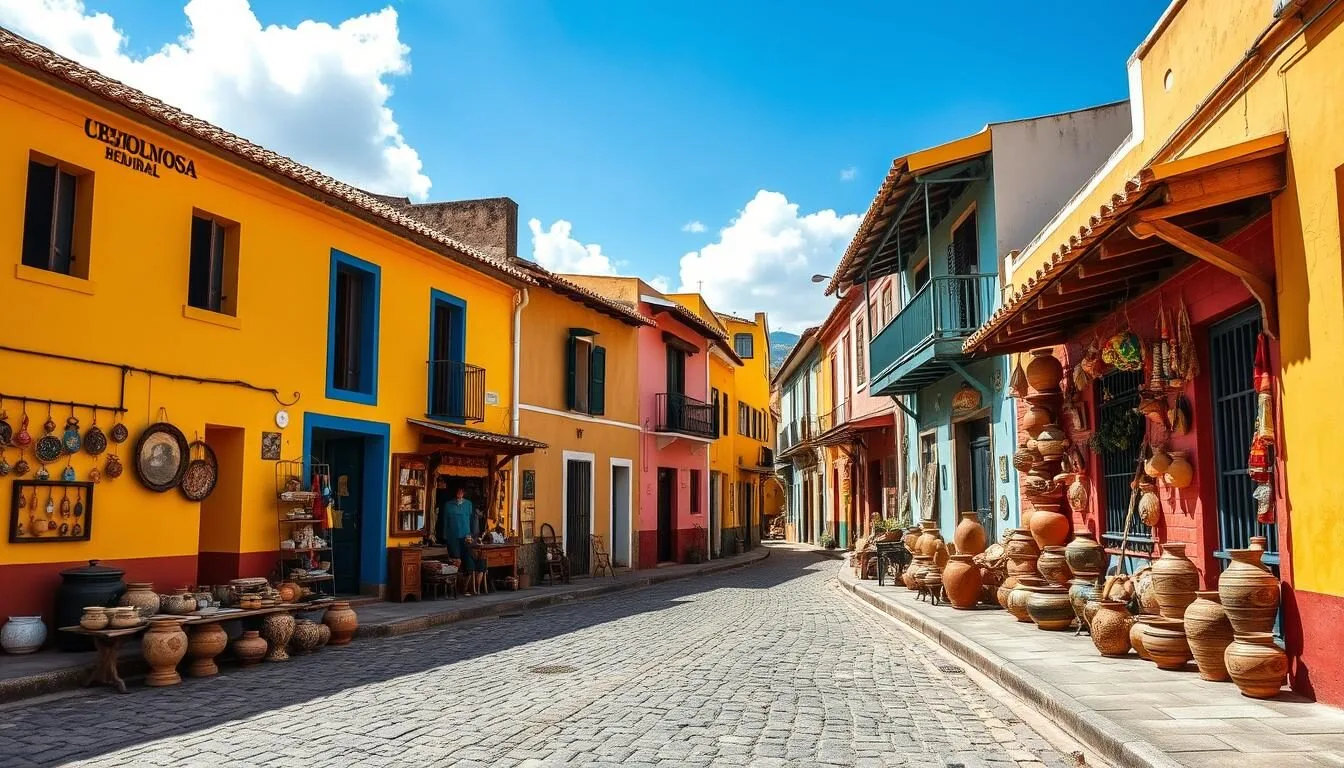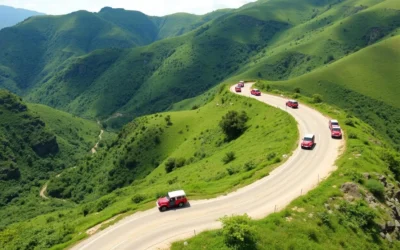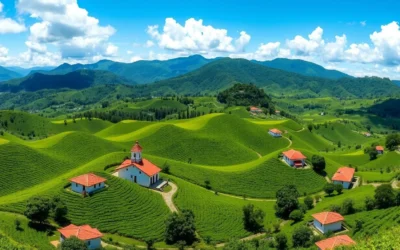Did you know that Raquira produces over 80% of Colombia’s handcrafted ceramics, earning it the title of “Pottery Capital of Colombia”? This vibrant town has been creating clay masterpieces since pre-Columbian times, with techniques passed down through generations. Nestled in the highlands of Boyacá, just a few hours from Bogotá, Raquira welcomes visitors with its rainbow-colored streets, rich artisanal traditions, and the earthy scent of clay that permeates the air.
Getting There & Planning Your Journey
Reaching Raquira is relatively straightforward, whether you’re coming from Bogotá or other popular destinations in Colombia. The town is located approximately 3-4 hours from the capital city, making it perfect for a day trip or weekend getaway.
From Bogotá:
- Take a direct bus from Bogotá’s Terminal Salitre or Terminal del Norte to Raquira (approximately 3 hours, 45,000 COP)
- Alternatively, take a bus to Tunja, then connect to Raquira (total journey about 4 hours)
- If you prefer flexibility, consider renting a car for the scenic drive through the Andean highlands
From Villa de Leyva:
- Local buses (“busetas”) run regularly between Villa de Leyva and Raquira
- The journey takes approximately 40 minutes and costs around 8,000 COP
- The last return bus typically leaves Raquira around 5:30 PM
Ready to Start Your Colombian Adventure?
Find the best flight deals to Colombia and begin your journey to Raquira’s colorful pottery paradise.

Best Time to Visit & Weather Tips
Raquira enjoys a mild climate year-round, with average temperatures between 12-18°C (54-64°F). The town sits at an elevation of about 2,150 meters (7,050 feet), giving it pleasant days and cooler evenings.
Dry Seasons (Recommended):
- December to March: Clear skies and minimal rainfall make this an excellent time for exploring the town and surrounding countryside
- July to August: Another dry period with comfortable temperatures and good conditions for outdoor activities
Rainy Seasons:
- April to June: Moderate rainfall, though mornings are often clear
- September to November: The wettest months, with afternoon showers common
For the best pottery shopping experience, consider visiting on weekends when the main square comes alive with artisans selling their wares. However, for a more peaceful experience with fewer crowds, weekdays are ideal.

Getting Around Locally
Raquira is a compact town that’s best explored on foot. The colorful streets are part of the charm, and walking allows you to discover hidden workshops and stores that you might miss otherwise.
Walking:
- The town center is easily walkable, with most attractions within a 10-15 minute stroll
- Wear comfortable shoes as streets are often cobblestoned or uneven
- The main shopping street and plaza can be thoroughly explored in 2-3 hours
For Surrounding Areas:
- Local taxis are available for trips to nearby attractions
- Some accommodations offer bicycle rentals for exploring the countryside
- For visiting multiple towns in the region (like Villa de Leyva and Raquira in one day), a rental car provides the most flexibility
Explore at Your Own Pace
Rent a car to discover Raquira and the beautiful Boyacá region on your own schedule.
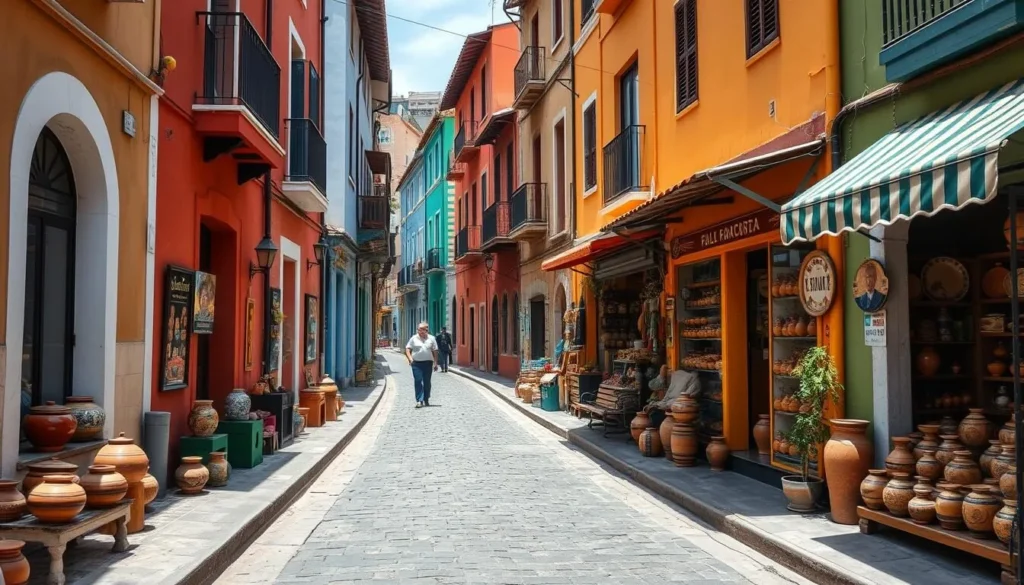
Where to Stay
While many visitors experience Raquira as a day trip from Villa de Leyva or Bogotá, staying overnight allows you to experience the town’s peaceful atmosphere after the day-trippers leave. Accommodation options range from budget-friendly hostels to charming boutique hotels.
In Raquira:
Hotel La Candelaria
A centrally located option with comfortable rooms, a terrace, and free private parking. Most rooms offer balconies with views of the colorful town.
Price range: 150,000-200,000 COP per night
Casona 1865
A historic property offering garden views, free WiFi, and a taste of traditional Colombian architecture. The peaceful setting makes it perfect for relaxation.
Price range: 180,000-250,000 COP per night
In Nearby Villa de Leyva:
Hostal Casa Beija Flor
A budget-friendly option with clean rooms, friendly service, and communal areas perfect for meeting fellow travelers.
Price range: 80,000-100,000 COP per night
Hotel Arco Iris
Located on higher ground with stunning mountain views, this romantic hotel features large windows, terraces, and fireplaces for cooler evenings.
Price range: 150,000-200,000 COP per night
Find Your Perfect Stay
Browse accommodations in Raquira and Villa de Leyva to complete your pottery pilgrimage.

Dining & Local Cuisine
Raquira offers authentic Boyacense cuisine, known for its hearty flavors and traditional preparation methods. Many dishes are served in the region’s famous black clay pottery, adding to the dining experience.
Must-Try Local Dishes:
- Ajiaco: A traditional Colombian soup made with three types of potatoes, corn, chicken, and guascas (an herb unique to Colombia)
- Longaniza: A type of thin chorizo sausage, especially famous in nearby Sutamarchan
- Arepa Boyacense: A sweet corn cake filled with cheese and often served for breakfast
- Cocido Boyacense: A hearty stew with beef, pork, chicken, potatoes, corn, and vegetables
Recommended Restaurants:
Cazuelas Boyacenses
Located on the main square, this restaurant serves traditional Boyacense cuisine in clay pots. Try their ajiaco or cocido for an authentic experience.
Price range: 15,000-30,000 COP per person
Restaurant Los Tiestos
A local favorite not far from the main square, offering regional specialties with generous portions and friendly service.
Price range: 18,000-35,000 COP per person
For coffee lovers, the small cafés around the main square offer excellent Colombian coffee, often served in handmade ceramic cups that you can purchase afterward as souvenirs.

Attractions, Sightseeing & Activities
Raquira’s main attraction is undoubtedly its pottery tradition, but the town offers several other points of interest that make it worth exploring.
Pottery Workshops & Shopping:
- Main Street Shops: Browse countless pottery stores selling everything from decorative pieces to functional cookware
- Pottery Workshops: Visit family-run workshops where you can watch artisans at work and even try your hand at the pottery wheel
- Todo Raquira Factory: A large pottery factory and store where you can see the entire production process
Plaza Principal:
- Admire the unique fountain featuring a “Manneken Pis” inspired figure
- See the large terracotta statues honoring local artisans and traditions
- Visit the San Antonio Church facing the square
- Browse the weekend market where local artisans sell their crafts
Nearby Attractions:
- Monasterio del Santo Ecce Homo: A 17th-century monastery located about 15 minutes from Raquira
- Laberinto de Raquira: A colorful life-sized maze that’s fun for all ages
- Casa al Revés Raquira: An upside-down house providing quirky photo opportunities
- World’s Largest Piggy Bank: A massive ceramic piggy bank at Finca Beraca
Experience Raquira’s Cultural Treasures
Book guided tours and activities to make the most of your visit to Colombia’s pottery capital.

Cultural Experiences & Workshops
Immerse yourself in Raquira’s rich cultural heritage by participating in hands-on experiences that connect you with centuries-old traditions.
Pottery Classes:
- Many local workshops offer pottery classes where you can learn basic techniques
- Sessions typically last 1-2 hours and cost between 30,000-50,000 COP per person
- Some workshops allow you to take home your creation after it’s fired (which may require staying in town an extra day)
Local Tip: Visit Alex’s pottery workshop for an authentic experience. For around 30,000 COP per person, you’ll get a factory tour and a mini-introduction to pottery. Contact via WhatsApp: +57 321 308 2699 (Spanish only).
Traditional Crafts:
- Watch local women weaving traditional ruanas (Colombian ponchos) using techniques passed down for generations
- Observe the creation of tagua jewelry, made from a sustainable plant material known as “vegetable ivory”
- Learn about natural dyeing processes using local plants and minerals
For a deeper cultural experience, try to time your visit with local festivals. The most important is the Festival of Pottery and Clay, typically held in October, featuring competitions, exhibitions, and cultural performances.

Outdoor Activities & Natural Attractions
While Raquira is primarily known for its pottery, the surrounding Boyacá countryside offers beautiful landscapes and outdoor adventures for nature lovers.
Hiking Opportunities:
- Cueva de la Fábrica: A short hike to natural caves with interesting rock formations
- Surrounding Hills: Gentle trails offering panoramic views of Raquira and the valley
- Laguna de Iguaque: A sacred lake for the indigenous Muisca people, accessible via a challenging hike (located closer to Villa de Leyva)
Countryside Exploration:
- Rent bicycles to explore the rural roads connecting nearby villages
- Visit local farms to learn about traditional agricultural practices
- Photograph the stunning Andean landscapes with their patchwork fields and mountain backdrops
The region’s biodiversity makes it excellent for birdwatching, with numerous Andean species inhabiting the surrounding forests and fields. Bring binoculars if you’re interested in spotting local wildlife.
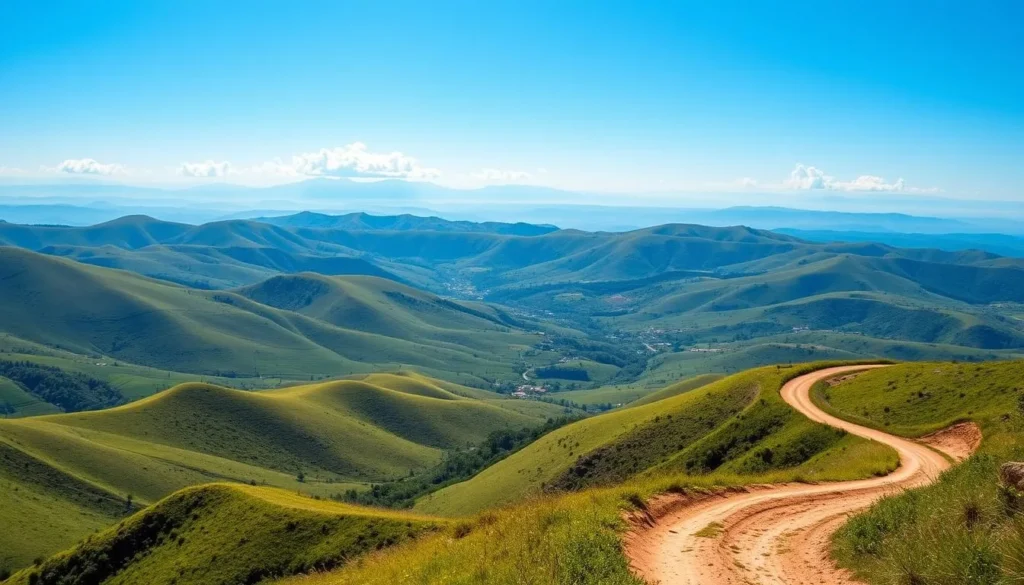
Souvenirs & Shopping
Raquira is a shopper’s paradise, especially for those interested in authentic Colombian handicrafts. The town offers some of the best prices for artisanal goods in the country.
What to Buy:
- Pottery: From decorative pieces to practical cookware, including the famous black La Chamba-style pottery
- Ruanas: Traditional wool ponchos that are perfect for cool Andean evenings
- Ceramic Piggy Banks: A local tradition, these “marranitos” are designed to be broken when full
- Hammocks: Colorful, handwoven hammocks that make perfect gifts
- Tagua Jewelry: Sustainable accessories made from palm nuts
Shopping Tip: Bring cash, as many small shops don’t accept credit cards. Some bargaining is expected, especially for larger purchases, but remember that these are handmade items representing hours of skilled work.
For the best selection, visit the shops along the main street leading to the plaza. Prices tend to be lower here than in more touristy towns like Villa de Leyva or Bogotá, making Raquira an excellent place to stock up on souvenirs.

Practical Travel Tips
Make your visit to Raquira smooth and enjoyable with these essential travel tips.
Money Matters:
- The currency is the Colombian Peso (COP)
- Bring sufficient cash as ATMs are limited and many shops don’t accept cards
- Expect to spend around 150,000-200,000 COP per day including meals, shopping, and activities
Language:
- Spanish is the primary language, with limited English spoken
- Learning basic phrases like “¿Cuánto cuesta?” (How much does it cost?) and “Gracias” (Thank you) will be helpful
- Many artisans are happy to demonstrate their craft even with language barriers
Safety & Etiquette:
- Raquira is generally safe, but standard travel precautions apply
- Always ask permission before photographing artisans or their work
- Respect the craftsmanship by not haggling too aggressively
- The town is at high altitude, so stay hydrated and pace yourself
Experience the Magic of Raquira
Raquira offers a unique glimpse into Colombia’s artistic soul, where ancient pottery traditions continue to thrive in a setting of extraordinary beauty. From watching skilled artisans transform humble clay into works of art to wandering streets alive with color and creativity, a visit to this ceramic capital promises memories as lasting as the pottery itself.
Whether you come for a day trip or linger longer to absorb the town’s peaceful rhythm, Raquira’s charm lies in its authenticity—a place where Colombia’s cultural heritage isn’t just preserved but vibrantly alive. As you return home with your carefully selected treasures, each piece will carry not just the imprint of the artisan’s hands, but the spirit of this remarkable Boyacá town.
Ready to Discover Raquira?
Start planning your Colombian pottery pilgrimage today!

The above is subject to change.
Check back often to TRAVEL.COM for the latest travel tips and deals.
